210 results
12th grade chemistry graphic organizers for Microsoft Word

Simple Microsoft Word Editable Printable Periodic Table Black and White
Microsoft Word Editable Printable Periodic Table Black and White
Contains various forms, including rounding the atomic mass to hundredths and ones place, with element names and with only element symbols, and a blank periodic table.
Can be edited to highlight the elements you want students to know.
Subjects:
Grades:
6th - 12th
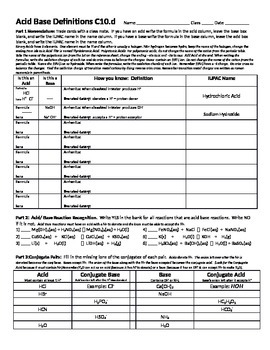
Conjugate Acid and Base
Card sort that instructs the students to use double replacement for the development of Acid-base reaction. Students will first use nomenclature to properly name acids and bases using Arrhenius and Bronsted-Lowry defintions. Second, recognize acid,base,conjugate acid, conjugate base and lastly, use a cardsort in a group activity to show the swapping of Hydrogen ions.
This activity is differentiated to help students that do not know double replacement yet.
Subjects:
Grades:
7th - 12th
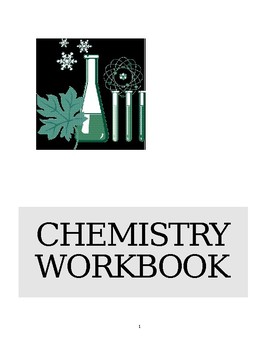
Complete Chemistry workbook for full year; editable Word version
This workbook is all you will need for an entire year of chemistry. If you are a new teacher, or an experienced teacher, this will provide you and your students with a standards based curriculum designed to spiral the material for mastery of content. I have been using this workbook for over a decade! My test scores are exceptional year after year. I have shared this resource with new chemistry teachers and first year teachers and they have been able to duplicate my success. This is a one st
Subjects:
Grades:
9th - 12th
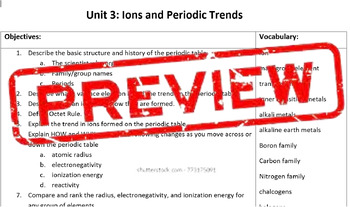
Chemistry Notes Packet (Periodic Table and Trends Unit)
This student packet goes through a unit on the Periodic Table and Periodic Trends and includes guided notes handouts, classwork handouts, a summative project, and a study guide. Big Ideas Covered: Periodic Table Structure, Atomic Radius Trend, Ionization Energy Trend, Electronegativity Trend.
Subjects:
Grades:
9th - 12th
NGSS:
HS-PS1-1
Also included in: Chemistry Semester 1 Guided Student Notes/Practice/Study Guide Packets
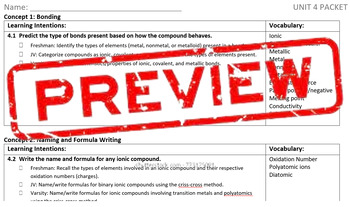
Chemistry Notes Packet (Bonding Unit)
This student packet goes through a unit on Bonding and includes guided notes handouts, classwork handouts, a study guide, and 1 Pager instructions and template. Big Ideas Covered: Types of Bonds, Properties of Ionic and Covalent Compounds, Naming and Formula Writing Ionic and Covalent Compounds.
Subjects:
Grades:
9th - 12th
NGSS:
HS-PS1-1
Also included in: Chemistry Semester 1 Guided Student Notes/Practice/Study Guide Packets

Chemistry Notes Packet (Atomic Structure and Nuclear Chemistry)
This student guided notes packet goes through a unit on Atomic Structure and Nuclear Chemistry. Big Ideas Covered: Atomic Structure, Isotopes, Average Atomic Mass, Radiation, Nuclear Reactions, Half-Life, and Fission/Fusion.The cover page of their note packet includes Learning Intentions and Success Criteria for the entire unit for the students to self-assess their understanding as they move through the unit. The packet includes guided notes through each big idea AND a study guide and 1 Pager in
Subjects:
Grades:
9th - 12th
NGSS:
HS-PS1-8
Also included in: Chemistry Semester 1 Guided Student Notes/Practice/Study Guide Packets
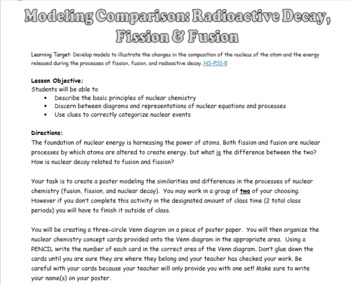
Modeling Comparison: Nuclear Decay, Fission & Fusion HS-PS1-8
In this activity students create a poster that compares the processes of nuclear decay, fission and fusion. This lesson works great for teaching NGSS standard HS-PS1-8 "Develop models to illustrate the changes in the composition of the nucleus of the atom and the energy released during the processes of fission, fusion, and radioactive decay". After spending a lot of time searching for a good activity I decided to create my own. It's based off of the idea of a card sort where students categorize
Subjects:
Grades:
9th - 12th

Chemistry Notes Packet (Electron Cloud Unit)
This student guided notes packet goes through a unit on the Electron Cloud. Big Ideas Covered: Atomic Models, Ions, Electron Configurations, Excited Electrons, Light Properties, and Light Calculations.The cover page of their note packet includes Learning Intentions and Success Criteria for the entire unit for the students to self-assess their understanding as they move through the unit. The packet includes guided notes through each big idea AND a study guide and 1 Pager instructions at the end.
Subjects:
Grades:
9th - 12th
NGSS:
HS-PS1-1
Also included in: Chemistry Semester 1 Guided Student Notes/Practice/Study Guide Packets
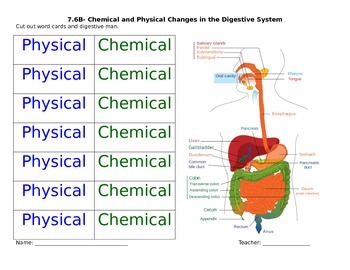
Physical/ Chemical Reactions in the Digestive System
Students first use organ cards and word cards ("Physical" and "Chemical") to identify what kind of change(s) is taking place at each location of the digestive system.
Students receive a handout of the human digestive system. In each of the parts of the digestive system, students need to write if there is a physical, chemical change, or both occurring in that location of the system. an article on the digestive system and a Key is included. Students can work with a partner to discuss what is
Subjects:
Grades:
6th - 12th
Types:

Flowchart Summarizing How to Name Chemical Formulas
Like all chemistry teachers, I dreaded the compounds unit because students always forgot naming rules or applied them incorrectly! I made this handout for students to practice naming compounds AFTER the students learned how to name binary molecules, ionic salts and metal oxides, and acids.
Rather than just hand this flowchart to students, you may wish to delete some or all text and have students write naming directions in their own words. Or delete the questions and have students work
Subjects:
Grades:
10th - 12th
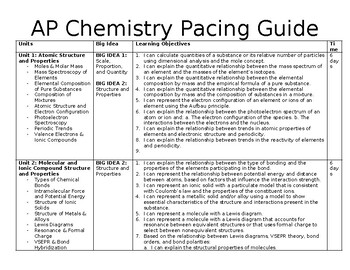
AP Chemistry Pacing Guide
AP Chemistry Pacing Guide for a semester-long AP Chemistry course!This document will include a graphic organizer showing:- Unit- Big ideas- Learning Targets as "I can" statements - Time spent in class on unit***FULLY EDITABLE WORD DOCUMENT***
Subjects:
Grades:
9th - 12th

Nuclear chemistry
Use this graphic organizer to summarize the most important takeaways from Nuclear Chemistry - fission vs. fusion; alpha, beta & gamma decay; history and medical uses of nuclear chemistry. Use the practice problems attached along with to practice decay equations.
Subjects:
Grades:
8th - 12th, Higher Education, Adult Education
NGSS:
HS-PS1-8
Also included in: Nuclear Chemistry
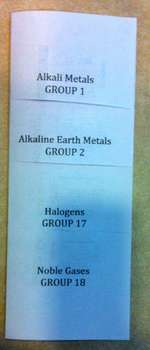
Periodic Table Groups Foldable
This foldable covers the four major groups in the periodic table: Alkali Metals, Alkaline Earth Metals, Halogens, and Noble Gases.
Simply print 2-sided (long-edge binding) and you have an example foldable for your class!
Subjects:
Grades:
9th - 12th, Higher Education, Adult Education
Types:

Nuclear Reactor
This is an interactive downloadable to help students understand the parts of a nuclear reactor while understanding the flow and type of energy at each step. You can use this worksheet to explain the conversion of energy from chemical to thermal to mechanical to finally electrical energy.
Subjects:
Grades:
8th - 12th, Higher Education, Adult Education
NGSS:
HS-PS1-8
Also included in: Nuclear Chemistry
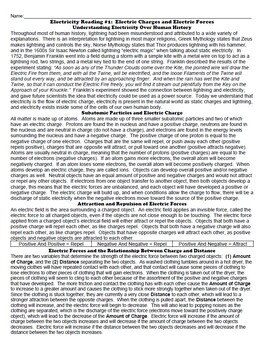
Electricity Reading #1: Electric Charges and Electric Forces- Read, Think, Draw
This resource is a Read, Think, and Draw of Electricity Reading #1: Electric Charges and Electric Forces. Through the reading students will learn about: Electricity and Lightning Through Human History, What is Electricity, Atoms, Subatomic Particles (Protons, Neutrons, Electrons), Protons have Positive Charges, Neutrons have Neutral Charges, Electrons have Negative Charges, Like Charges Repel, Opposite Charges Attract, Flow of Electrons and Charged Objects, Electric Field, Electric Force, Elect
Subjects:
Grades:
6th - 12th
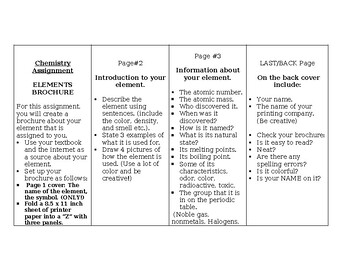
Element brochure
Students create a pamphlet advertising an element that they picked. Allow students to pick element. Students don't repeat element there are 118 to use. Elements 99 and above will not work for this assignment.Use the internet or the most recent uses and information.
Subjects:
Grades:
6th - 12th

Chemistry Unit Conversions, Metric Prefixes, Equations, & Constants
This is the reference sheet that I give my students for daily use and during tests. It has unit conversions like 1 mile = 5280 feet, and 1 atm = 760mmHg. It has all the metric prefixes with their meaning, power of 10, and relation to base unit. It also includes many commonly used chemistry equations like pH = -log[H+] and constants like c = 3.00×10^8 m/s. .docx file typeThe Chemistry Teacher WebsiteThe Chemistry Teacher on YouTube
Subjects:
Grades:
9th - 12th
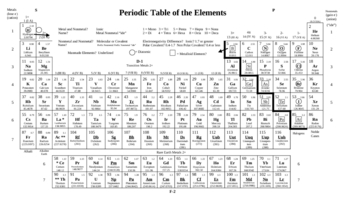
Editable Periodic Table of the Elements
This Periodic Table of the Elements has been created in Microsoft Word. Because of this, it is easily editable to whatever your preferences might be. With the Word file, you are free to add or delete any parts of the file before distributing to your students.
Subjects:
Grades:
6th - 12th
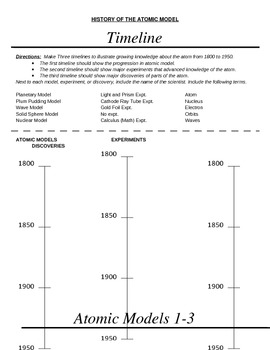
History of the Atomic Model Worksheets
This is a series of worksheets that can be used all together or as separate activities. Students need to create a timeline of the different atomic models, explain the experiments that led to these models, and identify the scientists responsible.
The answer key is included.
The images above are a little bit off.
Subjects:
Grades:
9th - 12th
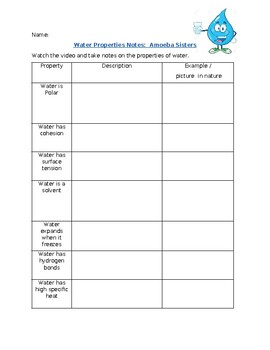
Properties of Water Graphic Organizer for Amoeba Sisters Water Properties video
Great for notes on water properties! Amoeba Sisters videos are engaging and informative, each property is described and summarized as well as an example given. The video is hyperlinked in the document. Students summarize each property and then provide their own example (or one from video) or they may choose to upload a picture that represents that property.
Subjects:
Grades:
4th - 12th
NGSS:
HS-PS1-3

Matter: Common Core Reading and Writing Activity
Matter: Common Core Reading and Writing Activity is an activity in which students read text about the the creation of matter and atoms within the universe. They will use this knowledge in higher order thinking skills such as application, analysis, and evaluation.
Grades:
3rd - 12th
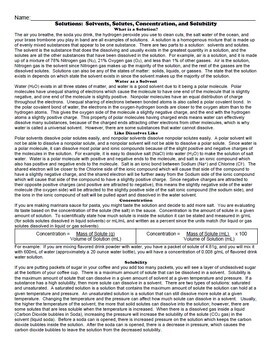
Solutions, Solutes, Solvents, Concentration, and Solubility- Read, Think, Draw
This resource is a Read, Think, and Draw about Solutions, Solvents, Solutes, Concentration, and Solubility. Through the reading students will learn about: What is a Solution?, Homogenous Mixtures, Solvents, Solutes, Water as a polar molecule, polar solvents dissolve polar solutes, nonpolar solvents dissolve non polar solutes, Concentration of solutes, solubility, saturated solutions, and unsaturated solutions.Teacher DirectionsPage 1 and 2 should be printed off front to back and given to the stu
Subjects:
Grades:
6th - 12th

Cycles of Matter in the Environment: Read, Think, and Draw
This resource is a Read, Think, and Draw about Cycles of Matter in the Environment. Through the reading students will learn about: the Law of Conservation of Mass, The Law of Conservation of Energy, The Water Cycle (Evaporation, Condensation, Precipitation), The Carbon Cycles (Carbon Dioxide in Plants, Cells in Cellular Respiration, Part of Cells, Fossil Fuels, and Carbon Dioxide in the Atmosphere), and The Nitrogen Cycle (Nitrogen Gas in the Atmosphere, Nitrogen as Part of Proteins, Nitrogen as
Subjects:
Grades:
6th - 12th

Determining Names of Organic Compounds: Student Handout and Answer Key
This resource is: Determining Names of Organic Compounds- Student Handout and Answer Key. Through this resource students will complete two parts: Part 1: determine the word parts that are used to name organic compounds (Word Parts for Number of Carbon Atoms, Word Parts for Number of Bonds Between Carbon Atoms, and Functional Group Names with Prefixes and Suffixes) Part 1 Example Students will fill in: Word Parts for Number of Bonds Between Carbon: 1 Bond= ane, 2 Bonds= ene, 3 Bonds= yne.
Subjects:
Grades:
6th - 12th
Also included in: Organic Compounds Bundle: 5 Resources
Showing 1-24 of 210 results







